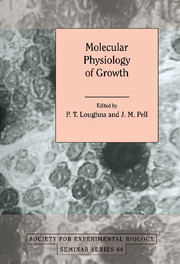Book contents
- Frontmatter
- Contents
- List of contributors
- The role of growth hormone in growth regulation
- Insulin-like growth factor-I and its binding proteins: role in post-natal growth
- Growth factor interactions in epiphyseal chondrogenesis
- Developmental changes in the CNS response to injury: growth factor and matrix interactions
- The role of transforming growth factor β during cardiovascular development
- Tenascin: an extracellular matrix protein associated with bone growth
- Compartmentation of protein synthesis, mRNA targeting and c-myc expression during muscle hypertrophy and growth
- The role of mechanical tension in regulating muscle growth and phenotype
- The pre-natal influence on post-natal muscle growth
- Genomic imprinting and intrauterine growth retardation
- Index
Insulin-like growth factor-I and its binding proteins: role in post-natal growth
Published online by Cambridge University Press: 19 January 2010
- Frontmatter
- Contents
- List of contributors
- The role of growth hormone in growth regulation
- Insulin-like growth factor-I and its binding proteins: role in post-natal growth
- Growth factor interactions in epiphyseal chondrogenesis
- Developmental changes in the CNS response to injury: growth factor and matrix interactions
- The role of transforming growth factor β during cardiovascular development
- Tenascin: an extracellular matrix protein associated with bone growth
- Compartmentation of protein synthesis, mRNA targeting and c-myc expression during muscle hypertrophy and growth
- The role of mechanical tension in regulating muscle growth and phenotype
- The pre-natal influence on post-natal muscle growth
- Genomic imprinting and intrauterine growth retardation
- Index
Summary
Introduction
Insulin-like growth factor-I (IGF-I) is a potent growth factor, stimulating cell proliferation and differentiation, depending on its environment. It consists of a single 70 residue polypeptide chain which is structurally related to proinsulin (50% homology) and IGF-II (70% homology). In the original somatomedin hypothesis (for review, see Daughaday & Rotwein, 1989), it was originally identified as a sulphation factor which mediated the anabolic actions of growth hormone (GH). Mature IGF-I has a molecular weight of about 7500 D and consists of four major domains: B, C, A and D when named by analogy with the B, C and A regions of proinsulin. Its sequence is conserved across many diverse mammals and other vertebrates implying evolution from a common ancestral gene and signifying its importance in normal development.
Unlike classical endocrine hormones but in common with many peptide growth factors, IGF-I synthesis is ubiquitous, its mRNA being found in most tissues and its local autocrine/paracrine functions being well-established (D'Ercole, Stiles & Underwood, 1984). However, IGF-I is unusual amongst growth factors in its high blood concentrations which may exert endocrine actions. The liver is likely to be the major source of this circulating IGF-I as it has the greatest abundance of IGF-I mRNA (Murphy, Bell & Friesen, 1987), and its measured synthesis of IGF-I peptide can account for the known turnover of IGF-I in the circulation (Schwander et al., 1983). In spite of its widespread distribution, very little IGF-I is present in the ‘free’ form, presumably due to its high potency; rather it is bound to one of six binding proteins which can regulate its bioactivity.
- Type
- Chapter
- Information
- Molecular Physiology of Growth , pp. 13 - 34Publisher: Cambridge University PressPrint publication year: 1996
- 1
- Cited by

